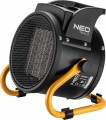Power consumption
The power consumed by the electrical components of the industrial heater during operation.
This parameter allows, first of all, to assess the load on the power grid and the suitability of the available power for the normal operation of the unit. It is relevant for all types of modern industrial heaters (see "Power supply"). However, it is worth noting that in some electric models, the power consumption is indicated for the ventilation mode. In this mode, the heating element is not activated, and the power consumption is extremely low — a few tens of watts. In such cases, the total power can be estimated from the maximum thermal output (see above) — in electrical models, these parameters practically do not differ from each other.
Airflow
The maximum amount of air that an industrial heater can pass through itself in a certain time.
This parameter is associated with an increase in air temperature (see above): at constant power, higher performance usually corresponds to a smaller temperature difference. Accordingly, a more efficient industrial heater will heat the entire volume of the room faster, but the heating temperature will be lower. So, it is worth choosing according to this parameter, taking into account what is more important for you — a large temperature difference or a high heating rate.
Power adjustment
The method of adjusting the heating power provided in the design of the heat gun.
- Stepped. Step adjustment assumes the presence of several fixed power values, between which switching is carried out during the tuning process. The accuracy of such a setting is worse than that of a stepless one (see below), even in cases where there are quite a lot of fixed values. At the same time, perfect accuracy is far from always required, and setting a specific value is easier than selecting the position of the regulator with stepless adjustment.
-
Stepless. Stepless systems include adjustment systems that do not have fixed steps and allow you to set the power value in any range from minimum to maximum. Due to this, this setting is extremely accurate, although in some cases it is not as convenient as the stepped one described above.
Protection class (IP)
An indicator that determines the degree of protection of dangerous (moving and current-carrying) parts of an industrial heater from adverse effects, namely solid objects and water. The level of protection is usually indicated by a marking of the letters IP ("ingress protection")) and two numbers, the first of which indicates protection against the effects of solid objects, and the second — against the ingress of water.
For the first digit, each value corresponds to the following protection values:
1 — protection against objects with a diameter of more than 50 mm (large body surfaces)
2 — from objects with a diameter of more than 12.5 mm (fingers, etc.)
3 — from objects larger than 2.5 mm (most instruments)
4 — from objects more than 1 mm (almost all tools, most wires)
5 — dustproof (full protection against contact; dust can penetrate inside, but does not affect the operation of the device)
6 — dust tight (case with full protection against dust and contact).
For the second digit:
0 — completely unsuitable for contact with water, the device requires protection from moisture and is not suitable for rooms with high humidity.
1 — protection against vertically falling drops of water
2 — from water drops with a deviation of up to 15 ° from the vertical axis of the device
3 — from water drops with a deviation of up to 60 ° from the vertical axis of the device (rain)
4 — against splashes from any...direction 5 — against jets from any direction
6 — from sea waves or strong water jets
7 — the possibility of short-term immersion to a depth of 1 m (without the possibility of continuous operation in immersed mode)
8 — the possibility of long-term immersion to a depth of more than 1 m (with the possibility of continuous operation in immersed mode).
The protection class of industrial heaters, usually, is quite low, because the very principle of operation of these devices involves an abundance of holes and openings.

